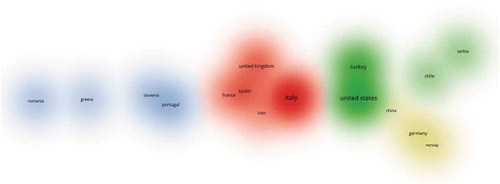ABSTRACT
Among the dried fruits, hazelnut cultivation represents one of the greater world productions. Based on this consideration, it has been decided to verify whether the great commercial importance of this fruit corresponds to an equally dynamic and productive scientific activity. The aim of this study is to analyze the network structure and the conceptual evolution of research on Corylus avellana through time. A scientific mapping approach was used and applied to a set of scientific publications from 1980 to 2019, retrieved from the Scopus database. From this period, the Scopus search provided 861 documents. During the 1980–1999 period, research topics were poorly characterized, but better defined in the 2000–2019 period. From 2000 to 2009, the research focused on three distinct areas of interest: (i) genetic techniques aimed at the study and resolution of phytosanitary problems; (ii) genetic improvement of new cultivars in order to obtain production quality; (iii) open-field cultivation techniques to improve the quantity of hazelnut production and the quality of the product. In the last decade (2010–2019), genetic improvement techniques, both in the laboratory and in the field, have merged into a single cluster using the most innovative molecular biology techniques. At the same time, the cultivation techniques were oriented not only toward production in the field, but also at studying and improving the quality of the products. Through the analysis was possible to trace some future lines of scientific research for this relatively unexplored topic.
Introduction
Native to Asia Minor, the hazelnuts (Corylus avellana L.), is one of the oldest plants cultivated by man. The hazelnut belongs to the Betulaceae family and is cultivated in many countries, such as Turkey, Italy, USA, Azerbaijan, Georgia, Spain, Portugal and France, as well as in regions of the Northern Hemisphere with a temperate climate (Topkafa et al., Citation2019).
There are most interesting species from the viewpoint of genetic improvement such as Corylus avellana, due to the characteristics of its fruits (Kanbur et al., Citation2013); Corylus maxima, due to its resistance to bud mites (Rodriguez et al., Citation1989); C. americana and C. colurna, as they can withstand low temperatures and diseases, and C. colurna and C. chinensis, which can produce non-suckering rootstock (De Salvador et al., Citation2008; Romisondo, Citation1976).
The average lifespan of this Corylus avellana is around 80–90 years (Clinovschi, Citation2005). Hazelnuts can be propagated both by seeds and vegetative ways (Monastra et al., Citation1996). A common method of vegetative propagation is via shoot and root suckers and cuttings (Contessa et al., Citation2011). In particular, it is able to sprout well and spread quickly after fires (Tinner et al., Citation1999). Thanks to its larger nuts and thinner shells compared with other hazelnut species, C. avellana has been used extensively in breeding programs (Erdoğan and Mehlenbacher, Citation2000), and there are now more than 400 described cultivars (Mehlenbacher, Citation1991). Unfortunately, hazelnuts have a well-known drawback: their pollen and nuts represent an important cause of allergic reactions in sensitive people (Enescu et al. Citation2016; Lauer et al., Citation2004; Nikolaieva et al., Citation2014).
The most valued part of these species is the fruit. From ancient times, hazelnuts have been among the main food components of our ancestors (Kubiak-Martens, Citation1999). In present times they are cultivated for their nuts and are one of the most economically important tree nut crops worldwide (Köksal et al., Citation2006). The nuts are rich in protein and contain significant amounts of vitamin E, thiamine, and magnesium (Enescu et al., Citation2016) and a complex of phytosterols which play an important role in the prevention of cardiovascular diseases.
The first five hazelnut producer countries in 2017 and 2018 were Turkey, Italy, the USA, Azerbaijan and China. Turkish hazelnut production in 2017 was 675,000 tonnes and in 2018 was 515,000 tonnes, which accounted for more than 66% and 57% of the worldwide production, respectively (FAOSTAT, Citation2020).
The filberts also represent an important food supply for many species during the winter, like several deer species, squirrels, dormice and birds (Rodolfi, Citation1994; Vander Wall, Citation2001). During the growing season, the leaves provide food for several animals, including invertebrates such as Lepidoptera spp. Recently, it was found that hazelnuts could be a good option for producing taxol, one of the most expensive anti-cancer drugs worldwide (Bestoso et al., Citation2006). Finally, hazelnuts are appreciated as an ornamental shrub, especially forms with unusual leaf morphology, namely the cutleaf hazelnut [C. avellana L. f. heterophylla (Loud.) Rehder] (Mehlenbacher and Smith, Citation2006). Nut yield and quality will increase in the event of more focused scientific research, thus making a positive contribution to the economy, both for hazelnut producers and their resident country (Şimşek and Kara, Citation2017).
Considering the different areas of core scientific interest, attention has been mostly focused on the exploration of the development and evolution of scientific works from 1980 to 2019. Therefore, the objectives of this paper are (i) to study the temporal trend of the last 40 years in the use of Corylus avellana in the agricultural research fields, in terms of number of papers, type of publications, journals, countries and authors involved by a bibliometric analysis, and (ii) to identify the major topics faced and keywords used in the scientific publications on agriculture via a science mapping approach.
Materials and Methods
The Corylus avellana literature search was performed using Elsevier Scopus electronic scientific databases, based on articles, conference papers, reviews, book chapters, notes, press articles and letters. The search terms were “Corylus avellana” in the title, abstract and keywords; only peer-reviewed documents published in English between 1980 and 2019 were considered.
In order to retrieve the documents of interest, we made a focused terminological search in the titles, abstracts and keywords. The terms of search were “Corylus avellana,” while the subject areas were limited to macro-areas such as ‘Agriculture, genetic improvement, pathogens and fruit quality.’ The following were then excluded from the search: (i) the subject area, irrelevant to the Corylus avellana based research sector (i.e., Earth and Planetary Science; Medicine; Immunology and Microbiology; Arts and Humanities; Social Science; Engineering; Chemical Engineering; Nursing; Multidisciplinary; Physics and Astronomy; Energy; Veterinary; Materials Science; Computer Science; Health Professions; Neuroscience; Mathematics; Psychology; Undefined); (ii) the terms like Quercus*, Fagus*, Betula*, Carpinus*, Salix*, Alnus*, Sorbus*, Crataegus, etc. The scientific journals which were investigated are: Acta Horticulturae, HortScience, Scientia Horticulturae, Journal Of The American Society For Horticultural Science, Journal Of Agricultural And Food Chemistry, Plant Cell Tissue And Organ Culture, Theoretical And Applied Genetics, Journal Of Phytopathology, Journal Of Plant Pathology, Physiologia Plantarum, Tree Genetics And Genomes, European Journal Of Horticultural Science, Plant Disease, Euphytica, Genetic Resources And Crop Evolution, HortTechnology, Phytopathology, Plant Breeding, etc. The search provided 861 publications.
The study of publications in a bibliometric analysis of science is divided into data recovery, pre-processing, network extraction, normalization, mapping and visualization analysis (Noyons et al., Citation1999; Börner et al., Citation2003; Morris and Van der Veer Martens, Citation2008). After that, the first pre-processing analysis was carried out according to Scopus statistics on the 861 publications recovered from 1980 to 2019. The temporal trend, the number of articles produced in the countries (minimum number of 10 publications) and the correlation between the number of publications produced and the relative citations were analyzed (Tatry et al., Citation2014). Finally, the most important journals from the nuts sector were considered, starting from 1997 (13 publications) as the number of publications in previous years was not very significant, with only one publication for Scientia Horticulture in 1988, and one publication in 1994 for HortScience. In addition, the Journal of Environmental Horticulture has been included as an emerging magazine, with four publications in 2019.
A second analysis was performed for network extraction, scientific mapping and visualization of the connections among the bibliographic data. For the scientific mapping, the VOSviewer software (www.vosviewer.com) was used (Van Eck and Waltman, Citation2010). First, a network is constructed on the basis of the data made available to VOSviewer. Then, accordingly, a score of relevance is calculated and a cluster related to the investigated domain of the analyzed publications identified is generated (Waltman et al., Citation2010). Finally, a map is created based on the constructed network (Raparelli et al., Citation2018; Van Eck and Waltman, Citation2014).
Scientific collaboration between countries or authors was quantified from 1980 to 2019, with a minimum of 10 considered documents for each country.
Based on bibliographic data, we analyzed the most used keywords and their connections in the Corylus avellana research field for 2000–2009 and 2010–2019.
Due to the slow evolution of research in the years prior to 2000 and the limited scientific contribution of few works, it was decided to focus interest specifically on the last 20 years of the covered period (1980 to 2019).
We only kept keywords with a minimum occurrence threshold of 5, i.e., the number of times a keyword must be present in the dataset to be used in the analysis. The terms “Corylus avellana” and “hazelnut” have been excluded from the mapping in order to avoid overcited keywords.
Then, we analyzed the text data and investigated the conceptual evolution of Corylus avellana in agricultural studies, for 2000–2009 and 2010–2019 separately. The minimum occurrence threshold for each term was set at 10, and the remaining 60% (default choice) most relevant terms were selected.
In order to avoid term repetition and to assure VOSviewer consistency, a thesaurus file of 535 entries was drafted prior to mapping. This file associates synonyms, different terms that express a unique concept, different spellings of the same word or of the same abbreviation, plural/singular terms, common/Latin names of plants, etc., with one unique related unambiguous term (Raparelli and Bajocco, Citation2019).
Results
In the period analyzed (1980–2019), the search for the Scopus archive identified 861 scientific publications. shows a stable trend of the number of Corylus avellana based scientific articles until 1996. After this date, there has been a clear, but inconstant increase, with some fluctuations in the annual number of publications. shows a peak of scientific works in the years 1994 (11), 1997 (24), 2001 (78), 2005 (56), 2009 (75), 2014 (69) and 2018 (88).
Figure 1. Trend in the annual number of scientific publications using Corylus avellana in agriculture research (1980–2019). Data directly extract from Scopus
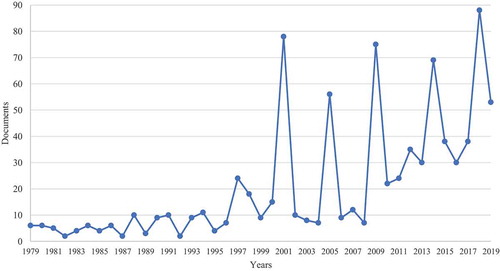
The scientific communications on hazelnuts published from 1980 to 2019 are widely distributed: 76.1% were research papers, followed by conference papers (21.0%), reviews (1.0%), notes (1.0%), book chapters (0.5%), and other documents, e.g., press articles (0.4%). shows the number of publications in each country and relative citations during the period from 1980 to 2019. Italy is the country with the most publications (220), cited 2258 times with a ratio equal to 1026%, followed by the United States with 188 documents and a ratio equal to 1347% and Turkey with 121 cited 888, with a ratio of 734%. It can be observed that Switzerland and Norway, each with 10 publications, reach citation values equal to 3890% and 4370%, respectively.
Figure 2. Number of scientific publications about Corylus avellana in agriculture research per Country, and related citations (1980–2019). Data directly extract from Scopus
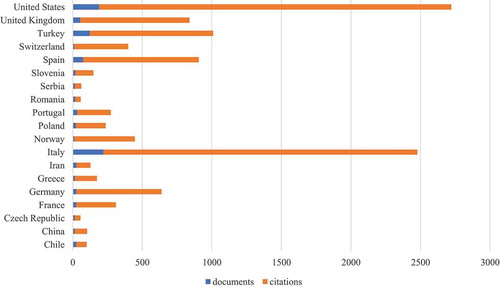
In order to make explicit the temporal distribution of the publications in the years examined, is produced. reorganizes the data in by dividing the number of publications according to the decades. It is possible to see the number of publications produced by the States in the four decades considered in this work, taking 10 as the minimum number of publications per decade. The table shows that both the United Kingdom and the USA have submitted publications in all 40 years. UK has a constant number of documents over time while the USA almost doubles publications from decade to decade. Italy and Spain began to publish internationally in the second decade (1990–1999). However, while Spain has remained at around 20 publications in the second and third decades (2000–2009), Italy increased its publications from 15 in the second decade to just above 100 in the third and fourth decades. Turkey and Portugal started producing more than 10 documents only in the third decade. In the last 10 years, publications in Chile (21 publications), China (10 publications), France (13 publications), Germany (16 publications), Iran (24 publications), Poland (17 publications), Slovenia (11 publications) have been noted.
Table 1. Number of scientific publications about Corylus avellana in agriculture research per Country per decade from 1980 to 2019 (10 is the minimum number of treated publications per decade)
A total number of 154 journals have been used to publish research on hazelnuts. shows that the most active journals were: Acta Horticulturae, with 290 documents; HortScience with 30 documents; Scientia Horticulturae with 18 documents. Journal of Environmental Horticulture was inserted in the group because of the publication of four papers in their first year of activity.
Figure 3. Trend of the most publishing journals about Corylus avellana in agriculture research (1980–2019). Data directly extract from Scopus

shows the data relating to the collaboration between different countries from 1980 to 2019. Seventeen States around the world have produced more than 10 publications over 40 years.
Figure 4. Scientific mapping of the collaboration among authors (1980–2019). Total strength = 1. Lines (300) indicate co-occurrence links between terms
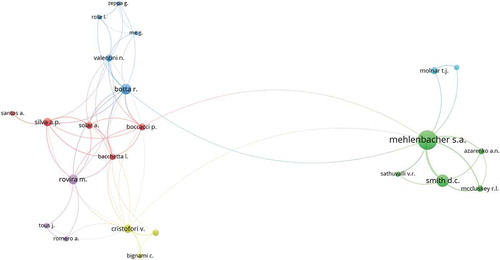
The main Countries are Italy, the USA, Turkey and Spain. In , it can be seen that the greatest production of scientific articles is represented by two distinct groups of States that collaborate with each other. Specifically, there are two main clusters composed respectively of Italy, the United Kingdom, Poland, Spain and Iran (red cluster), and the USA and Turkey (green cluster). Chile and Serbia are part of this second cluster but show less collaboration with the other States of the cluster. China is in contact with countries of the yellow cluster, such as Germany and Norway, and the green cluster. The blue cluster represents the following countries: Romania, Greece, Slovenia and Portugal. Among these four States, Slovenia and Portugal show the greatest collaborations.
shows well-defined working groups. There are 28 authors who have more than 10 publications. Five of them seem not to be part of consolidated research groups and therefore only 23 authors are considered. Most Universities and Research Institutes are represented (Università degli Studi di Torino, Università degli Studi della Tuscia (ITA), ENEA Agenzia nazionale per le nuove tecnologie, l’energia e lo sviluppo economico sostenibile (ITA), IRTA – Institute of Agrifood Research Technology (SP), Oregon State University, Cornvallis (USA), and other research Institutes.
As previously indicated, in the analysis of the keywords most used by the authors in the period from 1980 to 1999, the figure relating to the latter period is not reported as irrelevant. In fact, only six keywords are highlighted (anisogram, corylaceae, pollen, cultivars, nut, woodland). Thus, the interest of this study was focused on the period 2000 to 2019.
The clusters are grouped according to the keywords most used by the authors to characterize the study topic. For the decade 2000 to 2009, four distinct clusters relating to the topic reported in the article were highlighted ().
Figure 6. Scientific mapping of the networks among the keywords most used in the Corylus avellana agriculture research (2000–2009). Lines (300) indicate co-occurrence links between terms
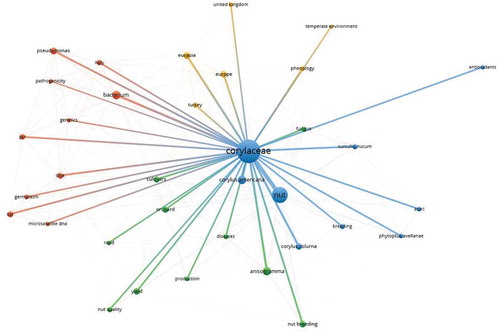
The blue cluster is composed by the words Corylaceae (in the center of the Figure), antioxidants, Curculio nucum, acari, Phitoptus avellanae, breeding, Corylus colurna, Corylus americana, and nut. The green cluster is composed by the words nut breeding, anisogramma, diseases, production, yield, nut quality, RAPD, orchard, cultivars and fungus.
In the red cluster, the words microsatellite DNA, SSR, germplasm, DNA, PCR, genetics pathogenicity, bacterium, pseudomonas, and Italy are found.
In the orange cluster, the words United Kingdom, temperate environment, phenology, Europe, Eurasia, and Turkey are found.
For the decade from 2010 to 2019, five distinct clusters are highlighted ().
Figure 7. Scientific mapping of the networks among the keywords most used in the Corylus avellana agriculture research (2010–2019). Lines (300) indicate co-occurrence links between terms
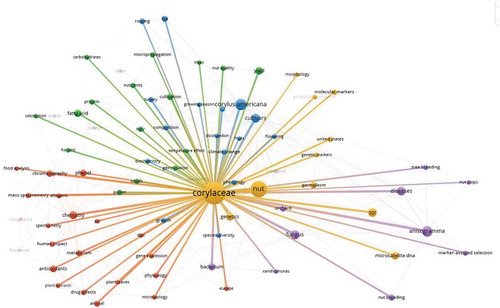
The orange cluster groups the following words: Corylaceae, germplasm, SSR, microsatellite DNA, United States, genetics, genetic markers, morphology, molecular markers, genetic differentiation.
The blue cluster groups the following words: cultivars, flowering, fruit, climate change, dicotyledon, species diversity, growing season, Turkey, composition, growth, phenology, Corylus americana, IBA, rooting, biochemistry.
The red cluster groups the following words: phenol, food analysis, chromatography, mass chromatography allergens, chemistry, PCR, spectrometry, human impact, metabolism, diet, gene expression, physiology, antioxidants, plant extracts, drug effects, plant leaves, animal, microbiology, Europe.
The green cluster groups the following words: yield, nut quality, trees, pollen, germination protein, fatty acid, temperature effect, calcination, harvest, seeds, micropropagation, cultivation, nutrients, Italy, carbohydrates.
The purple cluster groups the following words: fungus, bacterium, Xanthomonas, nut breeding, orchard, marker assisted selection, Anisogramma, diseases, nut crops, tree breeding.
As already indicated for the keywords, although the nominal phrases relating to the period from 1980 to 1999 have been analyzed, the relative figure has not been reported. In fact, there is a low number of connections for this period. Specifically, there are only 10 words (trees, year, growth, area, leaf, Corylaceae, dormancy, treatment, seeds).
represents the nominal sentences of publications produced between 2000 and 2009 (278 documents). There are three well-defined clusters that identify three macro-themes: production quality linked to production techniques (red cluster), production efficiency linked to the genetic selection of the different hazelnut cultivars (green cluster), and genetic improvement techniques applied to solve pathogenetic problems (blue cluster).
Figure 8. Term map based on title and abstract on Corylus avellana publications during 2000 e 2009. Lines (300) indicate co-occurrence links between terms
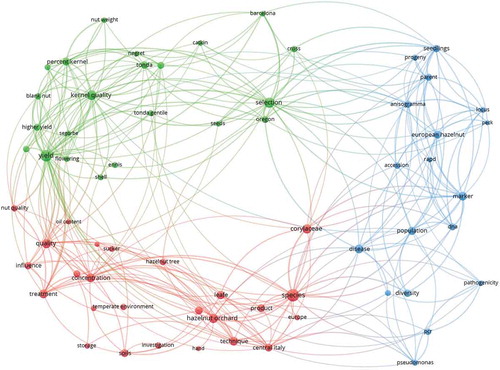
represents the nominal sentences of publications produced between 2010 and 2019 (429 documents). Only two distinct and clearly separated macro-areas are highlighted. The two clusters are connected only by two nominal sentences. In the red cluster the nominal phrase is represented by “yield” that is connected to the words selection, European hazelnut, Anisogramma and disease in the green cluster. The other nominal phrase is represented by “quality” (red cluster) that is linked to “ selection” and “disease” (green cluster).
Discussion
The hazelnut market, like the whole-dried fruit sector, has been subject to sudden changes and recurrent crises that have become increasingly important due to the expansion of world production and to the strong competition on the markets by Turkey (Güney, Citation2014), determining a downward trend in prices, a stability of consumption of hazelnut-based products and a considerable increase in production costs compared to other producing countries (Aydoğan et al., Citation2018).
The same fluctuating trend of markets is reflected in the trend of scientific productions, which show productivity peaks about every 4 years. It can be assumed that the explanation could lie in the cyclical nature of international conferences that specifically deal with hazelnuts, and the production of scientific works that are related to them. In fact, it can be noted that the peaks of publications produced in the years 1994, 1997, 2001, 2005, 2009, 2014, and 2018, correspond to the years in which the specific ISHS International Conferences were held on the topic, highlighting a clear positive correlation between the two sets of data.
With regard to the countries that have been involved in scientific research on hazelnuts, from the examination of the data extracted from Scopus database, it is noted that Turkey has produced a significant number of scientific documents since 2000. This would be in contradiction with the fact that this country has been the major producer of hazelnuts since 1980 and has maintained this world record to date (FAOSTAT, Citation2020).
Since 2000, Turkey has evidently filled the gap, becoming the third country in the world to produce more publications, as shown in and .
For the same reason, countries such as China, France and Iran are highlighted, which, although having hazelnut productions which have steadily stabilized in the last decade between 5th and 10th place in the world, are poorly productive on a scientific level. On the contrary, it is interesting to note some countries which, although scarcely invested in hazelnut cultivation, are instead very productive in the scientific field. Among these countries, Slovenia emerges which, with internal productions that rarely exceed 100 tons/year, produces a number of publications comparable to much more prolific countries, such as China and France (FAOSTAT, Citation2020).
It is interesting to note the scientific level of the publications in terms of citations achieved. Specifically, it can be seen that citations are not directly correlated with the number of publications. The best performance between the number of publications and related citations is achieved by Norway and Switzerland, followed by the USA, Italy, and Turkey. The first two countries have produced relatively few publications, compared to Italy, USA, and Turkey, but the works have probably been produced by scientific institutions which enjoy a better scientific reputation or have worked on innovative issues that arouse greater interest from other researchers in this sector (Kulak et al., Citation2019).
The collaborations between research Institutions which deal with hazelnuts are well defined and stable over time. Two separate groups are highlighted between those in progress, as shown in . The Cornell University (green cluster) is represented by a group of five researchers who collaborate with each other and occasionally with Rutgers University (Dr. Molnar TJ.). The leader of this group, Dr. Mehlenbacher S. A., represents the point of connection with a large group of European Universities and research Institutions.
In reverse, European research groups are linked by more consolidated collaborations, both between the Institution in which they belong and within the same organization. For example, it is possible to highlight the working groups set up in the University of Tuscia (yellow cluster), the University of Turin (blue cluster), the working group consisting of Spanish researchers (purple cluster) and finally a mixed group consisting of researchers belonging to various research Institutions (ENEA, University of Turin, University of Ljubljana, Universidade De Tràs os Montes e Alto Duro; red cluster).
As previously noted, in this case the scientific contribution from Turkish working groups or researchers is not evident. These researchers, although producing numerous scientific works, do not seem to be linked to stable working groups, but conduct their activities individually, and a self-referenced way. What has been said so far is supported by which highlights that Turkey is linked with the United States, which means that Turkey is one of the countries where publications on hazelnut are produced. An alternative explanation may lie in the fact that Turkish researchers do not work exclusively on the crop in question.
From the analysis of the keywords used by the authors from 1980 to 1999 (data not reported given the unfair number of publications), it is evident that scientific studies were mainly of a biological or environmental nature. In the second decade (2000–2009) the studies on genetics applied to culture both from the point of view of the genetic improvement of the various cultivars, and from that of the genetic characterization of the cultivars themselves, have been increased (). In the third decade (2010–2019) the panorama of scientific research was expanded, treating hazelnut crops from the point of view of the climate and the environment, based on climate change, in terms of profitability of crops, and finally from the point of view of the consumption of food products obtained from hazelnut and the wholesomeness of the products themselves ().
The analysis of the nominal sentences shows that the studies from 2000 to 2009 () have focused on three distinct areas of interest (i) genetic techniques aimed at the study and resolution of phytosanitary problems such as anisogram, the pathogenicity, etc. (ii) genetic improvement of new cultivars in order to obtain quality production (iii) open-field cultivation techniques to improve the quantity of hazelnut production and product quality. In the last decade (2010–2019), genetic improvement techniques both in the laboratory and in the field have merged into a single cluster, taking advantage of the most innovative molecular biology techniques discovered in the latter period (SSR, microsatellite marker, etc.) (Caramelli, Citation2009) (). At the same time, the cultivation techniques were oriented not only to field production but also aimed to study and improve the quality of the products, in terms of the nutritional and nutraceutical compounds of the fruit.
The evolution of scientific research on the topics also expressed with the application of new investigation and analysis models implemented in the last 10 years. Remote sensing is an example. From the first studies before the new century (Franco, Citation1997) up to the very recent H2020 Panteon project, various authors have tried their hand with modern data collection techniques (Aydinoglu, Citation2010; Fabi and Varvaro, Citation2009; Reis et al., Citation2011, Citation2006; Sener et al., Citation2013).
Some interesting future research lines can be identified through the study of the scientific areas addressed and explored in the last 40 years. The scientific approach applied to the study of hazelnut production has evolved toward a multidisciplinary and multisectoral approach as evidenced by the analysis of publications. For the next decade, without prejudice toward the problems caused by profitability of the crop linked to the costs of labor for the harvest, there is a need to further improve the agronomic and varietal management of hazelnuts. In addition, possible lines of scientific research related to the use of modern methods for the detection of environmental, phenological, and cultural data seem to emerge. This scientific branch is not yet thoroughly studied in hazelnut crops. In fact, there are still few publications that refer to the mechanization of the crop, the implementation of neural networks, the use of drones and other environmental remote sensing systems, which make the hazelnut culture still considered too tied to consolidated production methods and far removed from the so-called 2.0 agriculture.
Another area of interest would seem to emerge in the use of the fatty substances contained in hazelnuts in order to create new and innovative products, such as waxes, creams and other cosmetic or health-related products, as recently implemented for almond fruits. In fact, these innovative products, in addition to making it possible to create new and unexplored commercial niche markets, would also make it possible to cope with the recurrent hazelnut market collapse, due to years of overproduction or international political crises.
Declaration Of Interest Statement
The authors declare that they have no conflict of interest.
Acknowledgments
We are grateful to Miss Maddalena Leonardi for her English editorial contribution.
Additional information
Funding
References
- Aydinoglu, A.C. 2010. Examining environmental condition on the growth areas of Turkish hazelnut (Corylus colurna L.). Afr. J. Biotechnol. 9(39):6492–6502.
- Aydoğan, M., K. Demiryurek, and N.İ. Abaci. 2018. World hazelnut trade networks. Acta Hortic. 1226(1226):429–435. doi: 10.17660/ActaHortic.2018.1226.65.
- Bestoso, F., L. Ottaggio, A. Armirotti, A. Balbi, G. Damonte, P. Degan, M. Mazzei, F. Cavalli, B. Ledda, and M. Miele. 2006. In vitro cell cultures obtained from different explants of Corylus avellana produce Taxol and taxanes. BMC Biotechnol Dec 6, 6-45.
- Börner, K., C. Chen, and K.W. Boyack. 2003. Visualizing knowledge domains. Ann. Revi. Inf. Sci. Technol. 37(1):179–255. doi: 10.1002/aris.1440370106.
- Caramelli, D. 2009. Antropologia molecolare. Firenze, Italia: Firenze University Press.
- Clinovschi, F. 2005. Dendrologie. Editura Universitatii Suceava: 80–83.
- Contessa, C., N. Valentini, M. Caviglione, and R. Botta. 2011. Propagation of Corylus avellana L. by means of semi-hardwood cutting: Rooting and bud retention in four Italian cultivars. Eur. J. Hortic. Sci. 76(5/6):170–175.
- De Salvador, F.R., D. Lolletti, and E. Raparelli. 2008. Current progress in the hazelnut breeding program at the tree fruit research centre-Rome. Abstract - 7th International Congress on Hazelnut, Viterbo-Italy, 23-27 June.
- Enescu, C.M., T. Houston Durrant, D. de Rigo, and G. Caudullo. 2016. Corylus avellana in Europe: Distribution, habitat, usage and threats. In: J. San-Miguel-Ayanz, D. de Rigo, G. Caudullo, T.H. Durrant, and A. Mauri (eds.). Europe atlas of forest tree species. Luxembourg, Publ. Off. EU.:1.
- Erdoğan, V., and S.A. Mehlenbacher. 2000. Interspecific hybridization in hazelnut (Corylus). J. Am. Soc. Hortic. Sci. 125(4):489–497. doi: 10.21273/JASHS.125.4.489.
- Fabi, A., and L. Varvaro. 2009. Remote sensing in monitoring the dieback of hazelnuts on the 'Monti Cimini' district (Central Italy). Acta Horticulturae 845:521–526. doi: 10.17660/ActaHortic.2009.845.80.
- FAOSTAT database collections. 2020. Food and Agriculture Organization of the United Nations (FAO). Rome. http://www.fao.org/faostat/en/#home.
- Franco, S. 1997. Use of remote sensing to evaluate the spatial distribution of hazelnut cultivation: Results of a study performed in an Italian production area. ISHS Acta Horticolturae 445:381–398. IV International Symposium on Hazelnut. Ordu, Turkey. 30 July 1996. doi:10.17660/ActaHortic.1997.445.51.
- Güney, O.İ. 2014. Turkish hazelnut production and export competition. Yüzüncü Yil Üniversitesi Tarim Bilimleri Dergisi 24(1):23–29. doi: 10.29133/yyutbd.235912.
- Kanbur, G., D. Arslan, and M.M. Özcan. 2013. Some compositional and physical characteristics of some Turkish hazelnut (Corylus avellana L.) variety fruits and their corresponding oils. Int. Food Res. J. 20(5):2161–2165.
- Köksal, A.İ., N. Artik, A. Şimşek, and N. Güneş. 2006. Nutrient composition of hazelnut (Corylus avellana L.) varieties cultivated in Turkey. Food Chem. 99(3):509–515. doi: 10.1016/j.foodchem.2005.08.013.
- Kubiak-Martens, L. 1999. The plant food component of the diet at the late Mesolithic (Ertebolle) settlement at Tybrind Vig, Denmark. Veg Hist Archaeobot 8(1–2):117–127. doi: 10.1007/BF02042850.
- Kulak, M., A. Ozkan, and R. Bindak. 2019. A bibliometric analysis of the essential oil-bearing plants exposed to the water stress: How long way we have come and how much further? Sci. Hortic. 246:418–436. doi: 10.1016/j.scienta.2018.11.031.
- Lauer, I., K. Foetisch, D. Kolarich, B.K. Ballmer-Weber, A. Conti, F. Altmann, S. Vieths, and S. Scheurer. 2004. Hazelnut (Corylus avellana) vicilin Cor a 11: Molecular characterization of a glycoprotein and its allergenic activity. Biochem. J. 15 383(Pt2):327–334. doi: 10.1042/BJ20041062.
- McLaggan, D., N. Adjimatera, K. Sepčić, M. Jaspars, D. MacEwan, I. Blagbrough, and R. Scott. 2006. In vitro cell cultures obtained from different explants of Corylus avellana produce Taxol and taxanes. BMC Biotechnology 6(1):6–45. doi: 10.1186/1472-6750-6-6.
- Mehlenbacher, S.A. 1991. Hazelnuts (Corylus). Genetic resources of temperate fruit and nut crops. Acta Hortic. 290:791–836. doi: 10.17660/ActaHortic.1991.290.198.
- Mehlenbacher, S.A., and D.C. Smith. 2006. Self-compatible seedling of the cutleaf hazelnut. HortScience. 41:48–482. doi: 10.21273/HORTSCI.41.2.482.
- Monastra, F., E. Raparelli, and R. Fanigliulo. 1996. Clonal selection of “Tonda Gentile Romana”. ISHS Acta Horticolturae, 445:39-44. IV International Symposium on Hazelnut. Ordu, Turkey. 30 July 1996. doi: 10.17660/ActaHortic.1997.445.5.
- Morris, S.A., and B. Van der Veer Martens. 2008. Mapping research specialties. Ann. Revi. Inf. Sci. Technol. 42:213–295.
- Nikolaieva, N., J. Brindza, K. Garkava, and R. Ostrovsky. 2014. Pollen features of hazelnut (Corylus avellana L.) from different habitats. Mod. Phytomorphology 6:53–58.
- Noyons, E.C.M., H.F. Moed, and M. Luwel. 1999. Combining mapping and citation analysis for evaluative bibliometric purposes: A bibliometric study. J. Am. Soc. Inf. Sci. 50:115–131.
- Raparelli, E., G. Macari, M. Scaglione, S. Bajocco, and G. Scarascia Mugnozza. 2018. Structural trend and conceptual evolution of research on genetically modified organisms using a science mapping approach. J. Cleaner Prod. 205:329–338.
- Raparelli, E., and S. Bajocco. 2019. A bibliometric analysis on the use of unmanned aerial vehicles in agricultural and forestry studies. Int J Remote Sens 1–14. doi: 10.1080/01431161.2019.1569793.
- Reis, S., and K. Taşdemirb. 2011. Identification of hazelnut fields using spectral and Gabor textural features. ISPRS J. Photogramm. Remote Sens. 66(5):652–661.
- Reis, S., and T. Yomralioglu. 2006. Detection of current and potential hazelnut plantation areas in Trabzon, North East Turkey using GIS and RS. J. Environ. Biol. 27(4):653–659.
- Rodolfi, G. 1994. Dormice Glis activity and hazelnut consumption. Acta Theriol. 39(2):215–220.
- Rodriguez, R., A. Rodriguez, A. Gonzalez, and C. Perez. 1989. Hazelnut (Corylus avellana L.). p. 127–160. In: ed. Y.P.S. Bajaj. Trees II. Biotechnology in Agriculture and Forestry. Vol. 5, Springer, Berlin, Heidelberg.
- Romisondo, P. 1976. Aspectos de la biologia del avellano. Memoria I Congreso Internacional de Almedra y Avellana. Reus – Spain: 7–33.
- Sener, M., B. Altintas, and H.C. Kurc. 2013. Planning and controlling of hazelnut production areas with the remote sensing techniques. J. Nat. Sci. 16(1): KSÜ Doğa Bil. Derg. 16 (1):16-23.
- Şimşek, M., and A. Kara. 2017. Production potential and development opportunities of hazelnut (Corylus avellana L.) in Turkey. Proceedings of the VIII International Agricultural Symposium AGROSYM, Jahorina, Bosnia and Herzegovina, october 2017, 847–852.
- Tatry, M., D. Fournier, B. Jeannequin, and F. Dosba. 2014. EU27 and USA leadership in fruit and vegetable research: A bibliometric study from 2000 to 2009. Scientometrics 98(3): 2207–2222. doi: 10.1007/s11192-013-1160-z.
- Tinner, W., P. Hubschmid, M. Wehrli, B. Ammann, and M. Conedera. 1999. Long-term forest fire ecology and dynamics in southern Switzerland. J. Ecol. 87:273–289.
- Topkafa, M., H.F. Ayyildiz, and H. Kara. 2019. Halzenut (Corylus avellana) Oil. In: Book fruit oils: Chemistry and functionality. Ramadan, Mohamed Fawzy (ed.), Springer, 10:223–241.
- Van Eck, N.J., and L. Waltman. 2014. Visualizing bibliometric networks, p. 285–320. In: Y. Ding, R. Rousseau, and D. Wolfram (eds.). Measuring scholarly impact: Methods and practice. Berlin: Springer.
- Van Eck, N.J., and L. Waltman. 2010. Software survey: VOSviewer, a complete program for bibliometric mapping. Scientometrics 84:523–538.
- Vander Wall, S.B. 2001. The evolutionary ecology of hut dispersal. Bot. Rev. 67:74–117.
- Waltman, L., N.J. Van Eck, and E.C.M. Noyons. 2010. A unified approach to mapping and clustering of bibliometric networks. J. Inf. 4:629–635.

